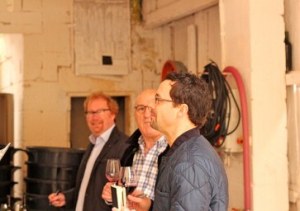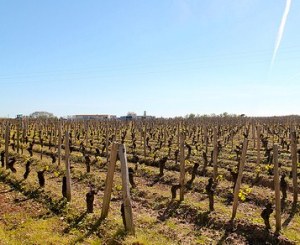Bank Shot: Kickin' It To The Right
Post by Chuck Hayward | April 13th, 2011
Following our adventures in the Medoc, the JJ Buckley team crossed the river for a crash course in the 2010 vintage from the perspective of the Right Bank, home to the famed appellations of Pomerol and St. Emilion and the ever-trendy (ahem) merlot grape. The last two vintages here have demonstrated a unique (and controversial for some) interpretation of their respective terroirs.

- JJB Sales Team Up Close and Personal with Christian Moueix (r)
First, it might bear noting that the Right Bank experience is an all-together different ball of wax to its Medoc counterpart. On the Left, the new vintages are generally poured and presented quietly, with a handful of winery personnel there for observation and information, much like docents in a museum. When the rare opportunity to speak with a chateau owner or executive presents itself, it is in hushed and reverential tones. On the other side of the Gironde, the wineries are smaller, the tastings more intimate, and conversation flows—frequently one-on-one with the proprietor or winemaker.

- Garagiste winemaker Michel Gracia (c) Sharing a Glass With JJB
In St. Emilion in particular, the wineries are miniscule in size compared to les grands chateaux of the Left Bank. This is the area where the term garagiste was born, and today you can still walk the narrow, winding streets of this town and find small wineries hiding, quite literally, behind unassuming garage doors. Only recently has this region begun to expand beyond the garage to take on a more "modern" feel. If any similarity between the two banks are to be found, it is in Pomerol. But even here, the similarities end with the architecture, and the intimate feel begins when the tastings commence.

- Vineyards at Cheval Blanc
When it comes to the 2010 wines, the differences between Right and Left become more dramatic. Thanks to warm growing conditions as harvest approached, the merlot-based wines of the Right were noticeably riper, with more of everything (more color, more flavor, more oomph!) in the glass. In this respect, they bore much similarity to their 2009 predecessors, but a closer look revealed some subtle differences.
In 2009, the wines of St. Emilion proved quite consistent across the board, with lush textures and integrated tannins showing in most examples. The 2010s, however, showed wider stylistic diversity, some with firmer tannins while others pushed the ripeness levels. The fortunes of Pomerol in 2010, however, seemed to have been reversed from 2009. In what was clearly an excellent year for this appellation, Pomerol showed much more consistency than St. Emilion and a high standard of winemaking was evident. For me, the tannins in the '09s from Pomerol were rougher and firmer in texture, which made the young wines seem very disjointed. But if there were tannin issues in 2010, they were hard to find. The young wines exhibited a fine profile that integrated beautifully with intense, pure fruit on the palate.
Overall, there are some fantastic '10s to be had in both regions, but buyers will want to seek a bit more guidance when making purchasing decisions. Our Bordeaux 2010 Report is in the works. Stay tuned!
New Video: Christian Moueix talks about the 2010 vintage and the unique differences between '09 and '10.